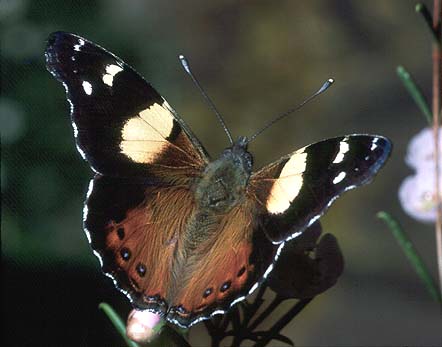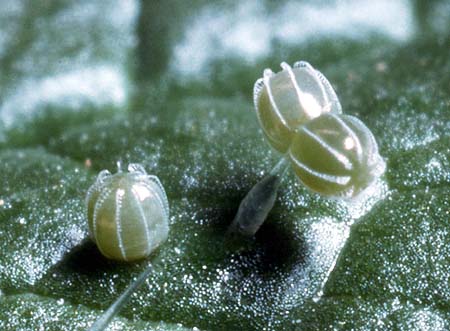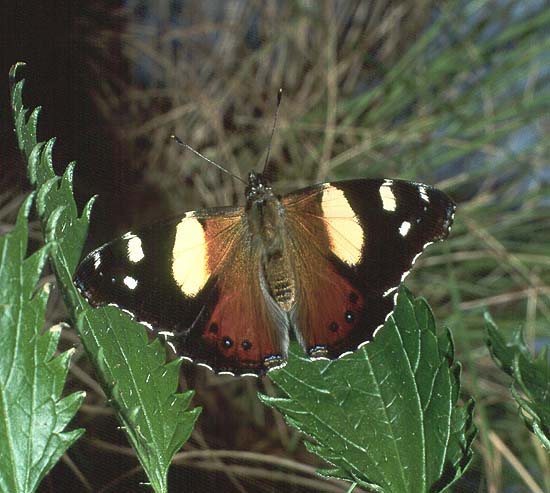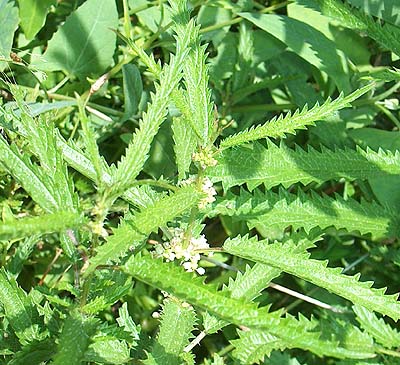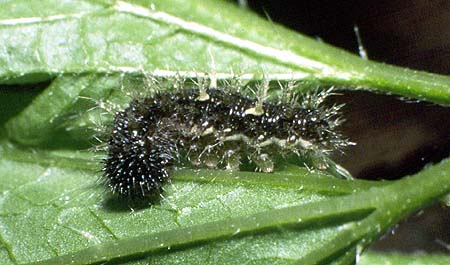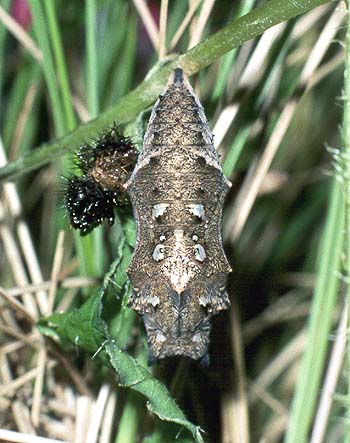-
Larval Food Host
-
Normally plants of the Urticaceae family, Parietaria australis,
P. cardiostegia (mallee smooth-nettle), P. debilis (smooth nettle),
*P. judaica (wall pellitory), *Soleirolia soleirolii (baby's tears),
Urtica incisa (scrub or native stinging nettle),
*U. urens (stinging nettle).
It has been known to utilise *Arctotheca calendula (cape weed) (Asteraceae)
but this is not a normal host. The larvae eat the leaves and softer green parts of
the hostplants, which are mostly annual but will remain perennial if there is
sufficient moisture. The butterfly is not known to utilise the tropical species of
nettles, but will use the temperate tolerant Urtica growing in tropical highlands.
-
Eggs
-
Initially pale green, small, barrel shaped, the height slightly greater than
the width, with 8-9 well developed, wing-like transparent longitudinal ribs
that enlarge apically and continue onto the top edge of the egg. Usually laid
singly on the hostplant, but sometimes in pairs, and mostly on the uppersides
of leaves. Eggs are also sometimes laid on debris adjacent to the hostplant.
Larval development within the egg commences immediately after being laid.
The egg shell is eaten by the larva after its emergence.
-
Larvae
-
Initially pale grey, long cylindrical shaped, with long hairs set on raised bases.
After eating the green leaves of the hostplant, the larva gradually becomes darker
in colour. Larvae of all instars construct leaf shelters on the hostplant in which
they hide from predators. The newly hatched larva constructs a shelter by rolling
or folding under the edge or tip of the leaf to make a small tubular shelter.
Subsequent instars take on a particular colour form (either dark or pale) and the
hairs develop into pointed, branched fleshy spines (scoli), which become progressively
larger and better developed with each instar. The leaf shelters also become progressively
larger and better developed, and by the third instar the entire leaf is folded into
a shelter, or the larva may use two or more leaves.
The final instar is about 32 mm long, cylindrical, covered in regular arrays of large
scoli on each segment, typical for the subfamily. There are usually seven scoli on
each segment, excepting the first segment which has none, the second and third segments
which have four scoli each, while the posterior two segments have only two scoli each.
There are numerous secondary setae, consisting of a fine white pointed hair set on
a simple raised white base. The final posterior segment is rounded. The head is rounded,
dorsally furrowed, smooth, but covered in spinose setae most of which have the lower
third developed into a thickened simple base, which differentiates these larvae from
those of V. kershawi which have head setae set on a short base. There are
sublateral hairs along the body. The colour is variable, either black, grey, grey-green,
yellowish-green or brown, with a darker dorsal line, and pale yellow subdorsal and
lateral lines. The latter lines may be discontinuous or occur as spots. Pale larvae
may be laterally darker, and sometimes there are red lateral markings. The scoli are
dark coloured in dark larvae, but pale translucent in pale coloured larvae.
The mature larvae feed openly during the day as well as at night, returning to hide in
their loosely formed leaf shelters when finished feeding. The larval duration is about
4-5 weeks during the warmer months, and larvae will develop during the winter months
if it is not too cold.
-
Pupae
-
Narrow elongate, angular, with a roughened surface, about 20 mm long ending in a
long posterior cremaster. Wedge shaped anteriorly with a pair of pointed apical
horns, a large keeled thoracic dorsal ridge, small dorsal abdominal projections,
a series of subdorsal projections, three pairs of large lateral projections along
with some small lateral abdominal projections, and a few small paired processes
ventrally. The colour of the pupae is variable. Pupation usually occurs off the
hostplant on an adjacent object or plant. These pupae usually match the substrate
to which they are attached, occurring in cryptic shades of grey, brown, or
grey-brown. The shape and colouration of the pupa closely imitates a dead,
shrivelled leaf. Those that remain on the hostplant often have a golden lustre
although the latter is sometimes indicative of parasitisation by small wasps.
There are paired, white, silvery-white or golden dorsal spots of irregular shape
and size, on the anterior half of the pupa. It is suspended head downwards by
the cremaster.
The pupal duration is about 10-14 days during the warmer months, extending to
25 days or more in winter.
-
Flight Period in South Australia
-
It is possible to find the butterfly in flight throughout the year, but is most
common during the warmer months. They often accompany the Australian Painted Lady
(Vanessa kershawi) during its migrations, tending to arrive in southern
areas in early spring. In southern areas adults can hibernate during winter.
The butterfly is capable of continuous broods if its hostplants remain in a green
condition, and a brood can be completed in about 7 weeks during summer. (In the
latter situation, the life of the colony is usually curtailed by a massive build
up of parasitoid wasps). It normally overwinters as larvae.

-
Distribution
-
Due to its migrant tendencies and its dependence on temperate species of nettles,
the butterfly can be found throughout sub-tropical and temperate Australia,
including Kangaroo Island and Tasmania. The butterfly will not normally tolerate
hot, humid tropical conditions, although there is a record of the butterfly being
found in Papua New Guinea. It is replaced in adjoining areas of Indonesia and Timor
by tropical tolerant V. indica derivatives.
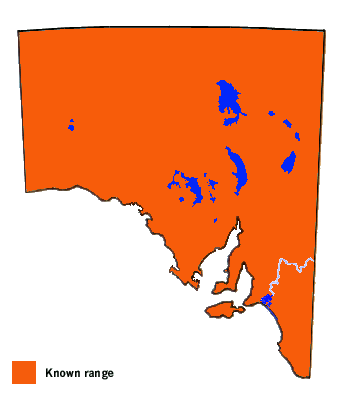
-
Habitat
-
Generally found wherever its hostplants occur, and these are locally common and
widespread but which thrive best in moist, temperate areas. The butterfly can
exist in hot, arid areas.
-
Conservation Status in South Australia
-
A nomadic migrant, rarely common, and is usually seen in very low numbers
near its hostplants unless in a migratory mode.
-
Threats
-
No major threats.
-
Conservation Strategy
-
None required. Will thrive in urban gardens.
